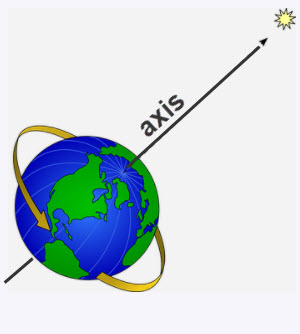
The Earth is in constant motion. As shown in the figure, the northern end Earth’s axis points toward the north star. Thus, Earth spins about it’s axis toward the east. Spinning about an axis is called rotation.
The Earth rotates once every 24 hours. It is this motion that causes daylight and nighttime.
Calculate the velocity of Earth’s rotation.
Note: The difference in speed and velocity is that velocity is always in a specific direction. Earth rotates toward the East.
The equation for calculating velocity is: V = D ÷ t
This equation is read as: velocity equal distance divided by time.
The velocity of Earth is different at different places because the circumference is different depending on the location on Earth. But regardless the location, the time from one revolution is 24 hours.
At the equator, the circumference of the Earth is 40,070 kilometers, and the day is 24 hours long. The velocity of Earth’s revolution at the equator is:
V =40,070 kilometers ÷ 24 hours = 1670 kilometers/hour ( 1070 miles/hr)
Since Earth is a sphere, the circumference is greatest at the equator and decreases at latitudes north or south of the equator.
Math Enrichment:
The velocity at different latitudes can be determined by this formula: Cosine of Latitude x 1670 kilometers/hour= velocity at a specific latitude Example: At latitude 45 degrees (North or South) the velocity would be: Cosine (45) = 0.707, thus the velocity of Earth at latitude 45 degrees would be— 0.707 x 1670 kilometers/hour= 1180 kilometers/hr